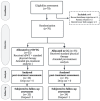Using Radial Shock Wave Therapy to Control Cerebral Palsy-Related Dysfunctions: A Randomized Controlled Trial
- PMID: 40098901
- PMCID: PMC11911230
- DOI: 10.2147/IJGM.S510383
Using Radial Shock Wave Therapy to Control Cerebral Palsy-Related Dysfunctions: A Randomized Controlled Trial
Abstract
Background: Radial Shock wave Therapy (rSWT) is one of the recent promising modalities that can effectively improve muscle tone, ROM, and enhance functional capacity. It can be used to augment the rehabilitation effectiveness in spastic CP children. So, enhance their engagement in community and participation in social activities and decrease economic burden of rehabilitation.
Purpose: To investigate the effect of adding rSWT to standard physical therapy on muscular spasticity, ROM, gross motor function, and planter surface in spastic CP patients.
Methods: A total of 70 children (48 girls and 22 boys) with spastic CP were randomly assigned into the control group (n= 35 and average age 8.82±0.91) which received standard physical therapy and the rSWT group (n=35 and average age 9.0±1.81) which received the standard physical therapy plus 1500 rSWT shocks with 2 bar pressure and Hz frequency applied over acupuncture points. Passive ankle ROM, calf muscle tone, gross motor function (D and E categories), plantar surface area (PSA), and peak pressure values at midfoot (PPMF), and hindfoot (PPHF) were assessed at baseline, post-treatment, and three-month follow-up.
Results: Between-group comparisons demonstrated post-treatment statistically significant differences in ankle plantar flexion (APF), walking category of the GMFM (GMFM-E), PPHF, and PPMF with medium to high effect size values favoring the rSWTG (p=0.011, d=0.858; p=0.003, d=1.02; p=0.035, d=0.577; p=0.049, d= 0.216, respectively). At follow-up, all outcomes were statistically significantly different (p<0.05).
Conclusion: rSWT is an effective addition to the standard physical therapy care for spastic CP children in favor of spasticity, ROM, and function.
Keywords: cerebral palsy; diplegia; hypertonia; shockwave; spasticity.
© 2025 Hussein et al.
Conflict of interest statement
We declare that we have no financial or personal relationships among the authors that could potentially influence or bias the content of this study.
References
-
- Corrado B, Albano M, Caprio MG, et al. Usefulness of point shear wave elastography to assess the effects of extracorporeal shockwaves on spastic muscles in children with cerebral palsy: an uncontrolled experimental study. Muscles Ligaments Tendons J. 2019;9(1):124–130. doi:10.32098/mltj.01.2019.04 - DOI
-
- Kwon DR, Kwon DG. Botulinum toxin a injection combined with radial extracorporeal shock wave therapy in children with spastic cerebral palsy: shear wave sonoelastographic findings in the medial gastrocnemius muscle, preliminary study. Children. 2021;8(11):1059. doi:10.3390/children8111059 - DOI - PMC - PubMed
Publication types
LinkOut - more resources
Full Text Sources
Research Materials
Miscellaneous


